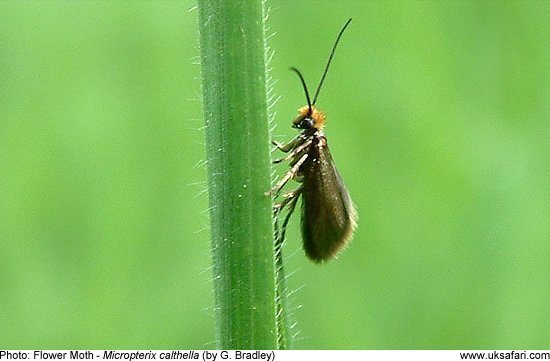
It may look fairly ordinary, but this little insect is a living fossil. It's the moth that time forgot. It's literally a dinosaur among Lepidoptera and it goes by the scientific name of Micropterix calthella.
Once upon a time, many, many years ago, the ancestors of todays butterflies and moths had mandibles for chewing their food instead of those natty looking curly tongues we see on most of them today. Somewhere along the evolutionary track (about 160 million years ago), when the curly tongues (known as a proboscis) became the trendy thing for moths and butterflies to have, this little guy decided it was one body modification too far.
You see as well as that rather fetching 1980's-Tina-Turner-esque hairdo, this little moth is still equipped with old-fashioned mandibles for chewing his food.
For some reason Micropterix decided not to go along with the curly tongue evolution, and yet the species is still with us, and is surviving very well. It makes you wonder why the other moths felt the need to change. Perhaps there wasn't enough pollen to go around, or maybe the competition for pollen was too great.
When you think about it that was quite an odd choice switching to an all liquid diet. Going from chewers to suckers doesn't really seem like like a great step forward for lep-kind. Did they really think that would give them a better chance of survival? I recently watched an episode of a TV programme called "What Happens in Kavos" and the youngsters there had switched to an all liquid diet. They didn't seem to be surviving too well.
Micropterix calthella, commonly known as Flower Moths, can be found throughout the UK, and at this time of year you'll often find them perched on a buttercup nibbling away at pollen grains.
